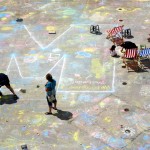Fellow MELA associates have highlighted how public space is an important arena for defining or even challenging our assumed roles as citizens. Realizing this potential can be a challenge when the idea of public space that we hold in common seems always under threat of being made more and more anodyne or being abandoned altogether.
Yet while it is increasingly easy for an individual to go about their lives without public encounters, in digital environments people are constantly meeting, converging, collaborating and influencing. To the extent that as Paul Mason says; “today the whole of society is a factory.” Where, “we all participate in the creation and recreation of the brands, norms and institutions around us”. How I wonder can public space, which is in effect a collectively owned ‘norm’ or ‘institution’ be constantly reinvented and reinvigorated?
In my own work as a designer I have been interested in how public spaces can be shaped by people’s diverse and active demands upon them and my understanding of this dynamic has evolved over time. When I started to practice my evaluation of public space was initially informed by my own experience, for example by a perception of a lack of safety or pleasure for women in urban environments. Later my critique was informed by my experience as a mother accompanied by children of different ages.
Over time the notion of my own experience as an ‘expertise’ was extended to the re-evaluation of the experience of other public actors: for example young men – one project was led by a young father who was concerned about keeping his younger brother out of trouble. As a starting point for a project he helped map a suburban area of Birmingham and make an inventory of the places that should have been accessible to young people but weren’t because they were being excluded in case they misbehaved.
How can public space be the foundation for people to play a proactive and meaning full part in civic life, like the young father in Birmingham was willing to do? What are the new kinds of participation and ownership that will enable public spaces and assets to be sustainably developed managed and governed?
As our conversations evolve I’d like to argue for an extended definition of public space, one that is large and small scale, urban and rural and that can engage with a wide range of public resources, including; food, water and energy. Perhaps Mela could bring together some of the inspiring stories about how people are co-creating public space to make more sociable and sustainable communities?
Here are some initial examples:
• In South Bristol in 2009 two friends and neighbours had the idea to close their street to traffic to create a temporary free play space. They have since persuaded the City Council that streets can be closed for two hours a week just by applying once a year. Their initiative called Playing Out brings communities together around the space of the streets they live in. Playing Out has gone on to form a Community Interest Company to support residents across the UK.
• In the small town of Wadebridge in Cornwall a not for profit company aims to enable the town to be supplied by 100% renewable energy by 2020 and by doing so reduce fuel poverty and develop new shared assets for the town. Currently run by volunteers with a membership comprising 20% of the population it plans to extend its energy initiatives through a Community Energy Company enabling it to raise and reinvest its own funds.
• CycleScape is an example of how users of public spaces are using digital sites to creatively impact on how urban spaces and transport infrastructure are designed and managed. A mapping tool for cycle campaign groups it enables cyclists nationally to generate ‘Crowd Sourced Cycling Solutions’ by posting their views about cycle routes and road junctions to shared maps. The tool shows how digital media can gather individual views and gain collective momentum.
In each of these projects the ability of people to network using social media has helped to grow or critique projects. In Paul Mason’s ‘factory’ (that spans cities, countries and communities) what is being produced is ‘shared knowledge and discontent’. I chose the examples of public space generation here because they show how people have realized productive conduits for discontent and are each collaborative, adaptive and empowering.
Juliet Bidgood is Architect/Urban Design at NEAT
PostCapitalisim: A Guide to Our Future – Mason, P. Allen Lane, 2015
playingout.net
wren.uk.com
www.cyclescape.org

